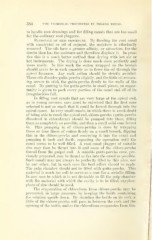Page 738 - My FlipBook
P. 738
384 THE TECHNICAL, PEOCEDXJEES IN FILLING TEETH.
to handle root dressings and for filling canals that are too small
for the ordinary root pluggers.
Rationale of this procedure. By flooding the root canal
with eneahq^tol or oil of cajnpnt, the moisture is effectually
removed. The oils have a greater afSnity, or attraction, for the
dentin than has the moisture and therefore displace it. In prac-
tice this is a much better method than drj-ing with hot air or
hot instruments. The drying is done much more perfectly and
more easily. In this work the cotton wrapped on the broach
should never be in such quantity as to force the oil through the
apical foramen. Any such action should be strictly avoided.
These oils dissolve gutta-percha slightly, and the little oil remain-
ing serves to stick the gutta-percha firmly to the walls of the
canal. By putting in the gutta-percha in small pieces, an oppor-
tunity is given to pack every portion of the canal and all of its
irregularities full.
In filling root canals that are very large at the apical end,
as in young persons, care must be exercised that the first cone
selected is not so small that it could be forced through into the
apical space. In very small canals, in which there is much doubt
of being able to reach the apical end, chloro-percha (gutta-percha
dissolved in chloroform) should be pumped into them, filling
them as completely as possible, and then a small solid cone forced
in. This pumping in of chloro-percha is done by wrapping
three or four fibers of cotton firmly on a small broach, dipping
this in the chloro-percha and conveying it into the canal and
pumping it back and forth, repeating the operation until the
canal seems to be well filled. A root canal plugger of suitable
size may then be thrust into it and some of the chloro-percha
forced from the pulpal end. A suitable gutta-percha cone, pre-
viously prepared, may be thrust as far into the canal as possible.
Such canals may not always be perfectly filled by this plan, nor
by any other, but in each case the best effort should be made.
The pulp chamber should not be filled with gutta-percha. This
material is much too soft to serve as a seat for a metallic filling.
In any case in which it is not desirable to fill the pulp chamber
with the material with which the cavity is to be filled, oxyphos-
phate of zinc should be used.
The evaporation of chloroform from chloro-percha may be
prevented, in large measure, by kee])ing the bottle containing
the solution upside down. By standing the bottle on its cork, a
little of the chloro-percha will pass in between the cork and the
opening of the bottle, and as the chloroform evaporates from this


